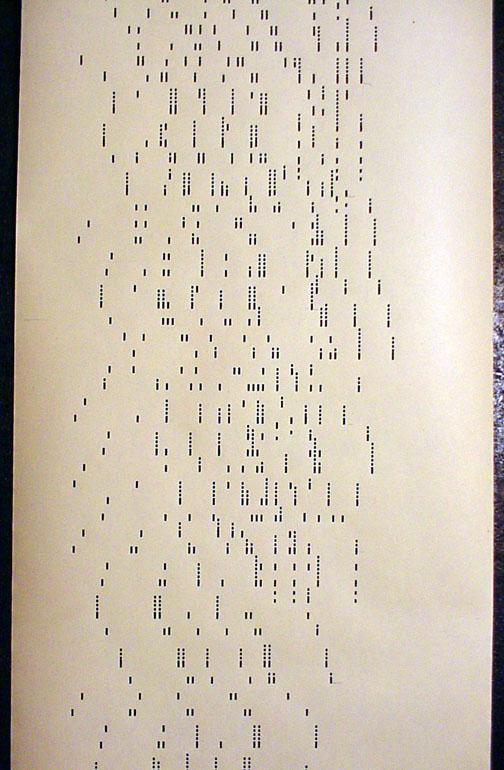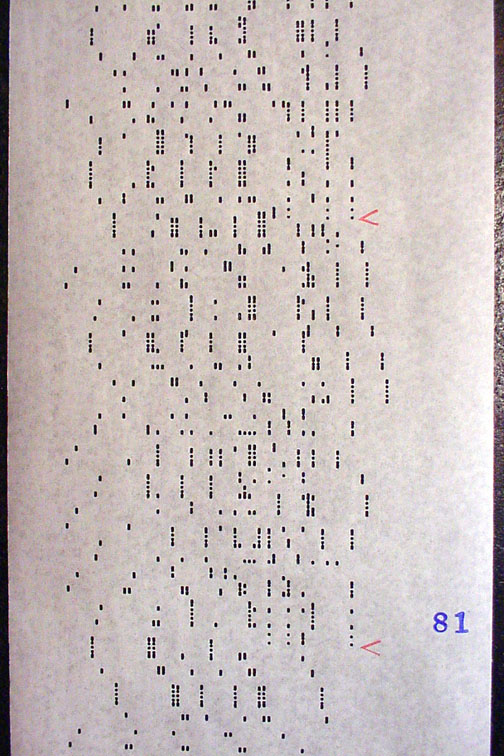1925 Pleyel arrangement: Roll III, Time Space #81

1991 ARTCRAFT Music Roll arrangement: Roll III, Time Space #81
We apologize for the "longer downloading time" of this Web page, but ... this features 2 of the same sections of BALLET MECANIQUE. Having contrasting examples next to each other should illustrate, visually, the major differences between Antheil's Pianola opus, both old and new.
Note that the staccato "added" rhythmic patterns (shown by red accent marks on the ARTCRAFT arrangement, below) are buried in the Pleyel arrangement. No Pianolist can "pull out" these notes effectively. Note also that the staccato patterns are really "not there" in the old Pleyel roll; the piano keys just press down as if an organist were at the keyboard. This is not good for music which supposedly reflects the electricity and precision of machinery!
1925 Pleyel arrangement: Roll III, Time Space #81

1991 ARTCRAFT Music Roll arrangement: Roll III, Time Space #81
You have already seen this picture below, but can refer back to ARTCRAFT Roll III, Time Space #81 if you wish to review the explanatory text. Scroll up and down between these 2 photographs, and you should notice the short, graduated staccato perforations and the "added" motifs on the ARTCRAFT roll, which are not present in the original 1925 arrangement. Without half trying, any Pianolist can "bring emphasis" to the new musical elements, when they occur. Such performance élan is completely impossible with the arrangement published in the composer's day.

BALLET MECANIQUE "revisionism" strikes again!
As stated previously, there's no end of 'fantasy' statements surrounding George Antheil's Pianola+film composition. This was due, in part, to the composer constantly redefining his own history.
(Later in life, he stated that BALLET MECANIQUE as a film and as a musical composition were "two parallel projects" which shared the same title. By 1953, composer Antheil wrote that the original Player-Pianos "don't exist any more" which could play his rolls ... when ... in fact they did, but, what he really meant to say was that the Pleyel arrangement didn't achieve his 'machine music' performance goals. Were he alive today, hearing the Interpretive Arrangement shown above, he'd realize that his original ideas were sound, but that the factory perforating methods prevented them from being realized in 1925.)
Thus, when a PROGAM for BALLET MECANIQUE (for Nov. 18, 1999, Durgin Hall, University of Massachusetts) states the following, this is just another in the stream of erroneous statements about the controversial Antheil music:
"Other performances of the piece, for pianola alone, took place in the 1930s and again in the 1990s after some of the Pleyel rolls were re-worked by Artcraft, a company in Maine."
"REWORKED"???
"REWORKED"??
Hardly! Anybody
can SEE that these two rolls are different, which is why the 1991 Set has
made the botched 1925 rolls musically obsolete, albeit historic!
The ARTCRAFT arrangement was done via musical analysis of recordings,
various BALLET MECANIQUE scores, "reading" (not copying or "reworking")
the Pleyel rolls on the Leabarjan perforator ... and finally, by making
use of the Pleyel score provided by The Antheil Estate. The modern rolls
were perforated with a thorough knowledge of what the Player-Piano can
and cannot do.
Accent, a music magazine for solenoid player dealers, just published another example of BALLET MECANIQUE misrepresentation in their Vol. 36, 2000 issue. This concerned the famous 1927 Carnegie Hall concert — featuring George Antheil at a Baldwin electrically-pumped player grand piano, surrounded by grand pianos played by human hands. One Pianolist was the central focus, as always. What does Accent say about the '27 musical event?
"This version made do with a single pianola and an unspecified multiple of two human-played pianos."
"MADE DO"?
"MADE DO?"
BALLET MECANIQUE was written for a single Pianola (or Fotoplayer), always with composer Antheil in charge of the mechanical music instrument. The Pleyel roll, shown above, has his own pencilled in directions for "slower here" ... "soft bass" ... "loud treble" and so forth, this being a roll supplied by the Estate for the Swedish TV-Radio project.
George Antheil used a Baldwin Welte-Mignon Licensee electric player grand piano that night, with an array of standard Baldwin grand pianos for the dynamic ballast. His instrument was an electrically-pumped 'reproducing' piano, but used with the Pianola hand controls. The stack might have been modified to operate the bottom 4 keys (transposing the "note cluster" from A-A#-B-C to C#-D-D#-E) ... or a full-scale 88-Note stack might have been installed for this particular concert, as Kohler & Campbell (builders of the Licensee action) also made 'Recordo' expression players using the same components. The printed programs for BALLET MECANIQUE at Carnegie Hall stated that the Baldwin was "the official piano" and that both the Welte-Mignon Original and the Welte-Mignon Licensee (which used the same rolls, but were built by different manufacturers) were "the official player" of the concert. Since the Baldwin Piano Co. of Cincinnati installed the Licensee expression player in their instruments, which featured graduating levers instead of buttons for the dynamic controls, it would be safe to assume that this is the instrument George Antheil (quote) "made do" with for that event.
We suggest that you question any self-styled expert? on the subject of this monumental music work, something which lent itself to many versions after the days of silent movies had ended. The chances are high that you are being "fed a line" ... when all is said and done!